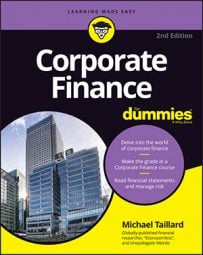Options in corporate finance are contracts that give the buyer the right to buy or sell a fixed number of goods at a predetermined price, but they don’t obligate the buyer to do so.
The two primary types of options are
Put options: When purchased, put options give the holder of the option the right to sell a predetermined unit quantity of some asset at a predetermined price, called the strike price, before some predetermined future date, called the expiration date.
Call options: Call options work in a very similar manner, except that they give the buyer the option to purchase those goods rather than sell them. When buyers decide to use the option to buy or sell goods, they exercise their option; when they decide not to use the option, they either let the option expire or, if possible, try to resell it.
Risk management
Companies can use both put and call options as tools for managing risk. For example, when you buy a put option, your goal is to make sure you can sell your goods for the best price possible. The put option might say, for example, that you have 10 tons of candy corn to sell at a strike price of $10,000.
If the price goes down between the purchase of the put option and the expiration date, then you would exercise your option in order to sell the candy corn for a higher price than what the market is currently offering. If, on the other hand, the price goes up, you would let the option expire because you could sell the candy corn for a higher price on the market.
Call options allow companies to purchase goods at the strike price. Continuing with the candy corn example, to limit risk, an interested buyer might purchase the call option with a strike price of $10,000 for 10 tons of candy corn in order to get the lowest price possible.
If the price goes down before the expiration date, the buyer will simply let the contract expire and buy the candy corn on the market for the lower price. If the price goes up, however, then the buyer will exercise the call option in order to buy the candy corn more cheaply than the market is currently offering.
Options and revenue generation
In case you’re wondering, options aren’t sold for free. The seller of the option generates revenue equal to the sale price of the option (which also floats in a manner similar to stocks based, in part, on investor sentiment and the belief of future potential), which gives the seller incentive to sell the options; however, the seller must use them carefully because risk is involved.
This is true for both call and put options; they both generate sales revenues but also obligate the seller to a future transaction that may not be in the seller’s best interest. The seller of an option is planning to either buy or sell the goods at the strike price anyway or betting that the buyer won’t exercise the option due to price conditions that are unfavorable for the buyer.
In the case where a seller sells options purely to generate revenue without any expectations of participating in an exchange at the strike price, that seller puts himself at great risk of losses or potential losses that aren’t otherwise recorded on standard financial reports, which can cause concern for investors as well as the company itself.
Valuation
Multiple mathematical models have been developed for the purpose of estimating the value of an option. Just one of the more popular valuation equations is discussed here along with how you can apply it in an investing portfolio strategy.
To find the value of selling an option, simply use this equation:
P + X = Value of selling an option
In this equation, P is the price of the option sold, giving the seller revenues, while X is the value of the exchange to the seller. Note that you can assume that X will always be negative; otherwise, the option holder wouldn’t exercise the option in the first place, which would leave X at 0, meaning the seller generated only revenues.
The equation for finding the value of buying an option is just as easy:
X – P = Value of buying an option
In this equation, you subtract the buying price (P) from the value of the exchange to the buyer (X). You can assume that X is always positive here; otherwise, the buyer wouldn’t exercise the option, leaving P equal to 0, meaning that the buyer lost only the cost of buying the option in the first place.
The more complex and arguably more accurate valuation methods all incorporate two major elements:
Value over time: The value of an option changes over time relative to increases in the risk-free rate and the underlying assets.
Probability of a particular outcome and the value placed on that probability: The likelihood of the anticipated event is weighted by the influence that the event will have.
Option valuation holds a special place in the hearts of investors because it allows for some very effective portfolio strategies. After all, options allow investors to set parameters on the amount of loss or gain they can experience.
For example, if an investor were hoping to limit his potential losses, he would purchase a put option only. If an investor were planning to sell his stock after the price goes up, then he could sell call options at that price, generating income on the call options in addition to the revenue he makes from selling at the higher price.
In turn, he could use the revenue generated from selling the call options to purchase the put options for mitigating loss, creating a strategy called a straddle.

